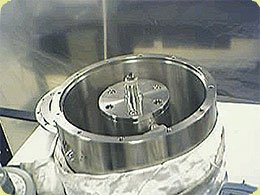- Joined
- 9 October 2009
- Messages
- 21,973
- Reaction score
- 13,624
Future Submarine Propulsion System?
By AW1 Tim
Categories: Uncategorized
Well….. My shipmate, YN2 H Lucien Gauthier III had a nifty find which I believe should be seriously looked at.
Mitsubishi, through it’s Public Affairs Committee, serves notice it has developed a fossil-fuel free motor. It works, though it’s still in development.
Mitsubishi Corporation (MC) and the Tokyo Institute of Technology (Tokyo Tech) have recently made a significant announcement—the completion of a first prototype CO2-free engine called the Magnesium Injection Cycle (MAGIC) engine. Although still at the experimental stage, this joint project, initiated in 2005, has developed a prototype that has successfully worked without the need for fossil fuels.
Power is generated by the chemical reaction between magnesium and water, which produces high-power steam and hydrogen. The hydrogen is burned at the same time to produce more high-power steam, and the two steam sources power the engine. The new technology produces no carbon dioxide or other harmful emissions and the only by-products from this reaction are water and magnesium oxide. The magnesium is separated from the oxide through a solar-powered laser process and is reused over and over again as fuel. This clean energy cycle, which is supported by solar power, has the potential to steer society away from its dependence on fossil fuels, and could bring about a paradigm shift in the way future energy needs are met.
The new MAGIC technology is very versatile, and has potential for use in cogeneration, automobiles, ships and many other areas. MC and the Tokyo Tech team believes it will take another three years of further research and experimentation before it is launched for commercial use.
Now, the corporation is talking about powering the laser used to support the system with solar power. That’s all well and good, but it seems to me that running a feed off an SSTG could provide all the power that that laser would need.
If this system works as they believe it will, it might be able to replace not only diesel engines in conventional submarines, but potentially, scaled up, replace nuclear plants.
This looks very promising to me, and I will be keeping an eye on this project as it develops.
http://aw1tim.wordpress.com/2011/05/25/future-submarine-propulsion-system/
By AW1 Tim
Categories: Uncategorized
Well….. My shipmate, YN2 H Lucien Gauthier III had a nifty find which I believe should be seriously looked at.
Mitsubishi, through it’s Public Affairs Committee, serves notice it has developed a fossil-fuel free motor. It works, though it’s still in development.
Mitsubishi Corporation (MC) and the Tokyo Institute of Technology (Tokyo Tech) have recently made a significant announcement—the completion of a first prototype CO2-free engine called the Magnesium Injection Cycle (MAGIC) engine. Although still at the experimental stage, this joint project, initiated in 2005, has developed a prototype that has successfully worked without the need for fossil fuels.
Power is generated by the chemical reaction between magnesium and water, which produces high-power steam and hydrogen. The hydrogen is burned at the same time to produce more high-power steam, and the two steam sources power the engine. The new technology produces no carbon dioxide or other harmful emissions and the only by-products from this reaction are water and magnesium oxide. The magnesium is separated from the oxide through a solar-powered laser process and is reused over and over again as fuel. This clean energy cycle, which is supported by solar power, has the potential to steer society away from its dependence on fossil fuels, and could bring about a paradigm shift in the way future energy needs are met.
The new MAGIC technology is very versatile, and has potential for use in cogeneration, automobiles, ships and many other areas. MC and the Tokyo Tech team believes it will take another three years of further research and experimentation before it is launched for commercial use.
Now, the corporation is talking about powering the laser used to support the system with solar power. That’s all well and good, but it seems to me that running a feed off an SSTG could provide all the power that that laser would need.
If this system works as they believe it will, it might be able to replace not only diesel engines in conventional submarines, but potentially, scaled up, replace nuclear plants.
This looks very promising to me, and I will be keeping an eye on this project as it develops.
http://aw1tim.wordpress.com/2011/05/25/future-submarine-propulsion-system/

